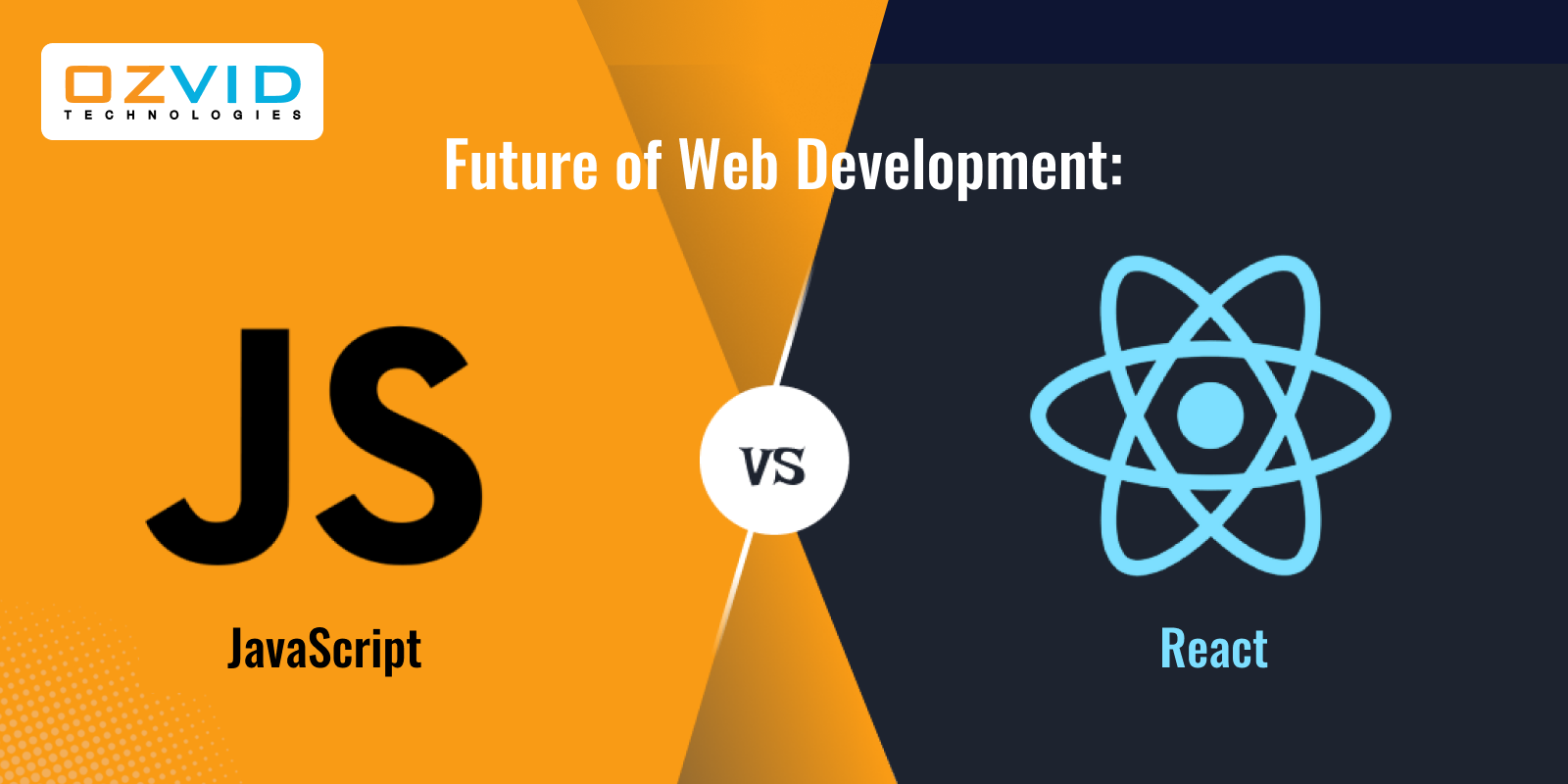- May 14, 2025
- Web Development
- 11423
Share this post on:

In the fast-evolving world of web development, keeping up with the latest technologies and frameworks is crucial for developers and businesses. As we step into 2024, the debate between using React and traditional JavaScript continues to shape the landscape of web app development. This blog aims to explore the current state and prospects of React and JavaScript, examining their roles, benefits, and challenges in the context of modern web applications.
Key Takeaways:
- React is ideal for building complex, interactive web applications with reusable components, while JavaScript remains the core language powering web development.
- React simplifies scalability, performance, and state management for larger projects.
- JavaScript is still essential for simpler projects but requires more manual handling of complex UIs.
- Both React and JavaScript will evolve, continuing to shape web development in 2024 and beyond.
The Evolution of Web Development
Web development has come a long way since the early days of static HTML and CSS. With the rise of dynamic and interactive web applications, developers have sought more efficient and scalable solutions. The introduction of JavaScript in the mid-1990s revolutionized how websites interacted with users. Over the years, JavaScript has evolved, and frameworks like React have emerged to address new challenges in web app development.
Understanding JavaScript in 2024
JavaScript, the foundational language of the web, remains indispensable. It powers client-side interactivity, server-side operations, and everything in between. Here’s a look at how JavaScript is shaping the future of web development:
1. JavaScript ES2024 and Beyond:
JavaScript continues to evolve with regular updates. ES2024 introduces new features such as enhanced pattern matching and improved async capabilities. These updates streamline development processes and enhance code readability, but developers still need to manually handle complex UI interactions and state management.
2. Performance Optimization:
Advances in JavaScript engines and performance optimizations, such as Just-In-Time (JIT) compilation, have significantly improved the speed of JavaScript applications. This makes JavaScript-based solutions viable for high-performance needs, though they might require more effort for complex UIs compared to modern frameworks.
3. Tooling and Ecosystem:
The JavaScript ecosystem has grown robust, with tools and libraries that aid development. Libraries like Lodash for utility functions and Axios for HTTP requests are commonly used. Despite this, managing dependencies and ensuring consistency across large projects can be challenging.
4. Vanilla JavaScript vs Frameworks:
For simpler projects, vanilla JavaScript is often sufficient. However, as applications become more complex, developers face difficulties managing state, routing, and component lifecycle without additional libraries or frameworks.
React: A Modern Approach to Web Development
React, developed by Facebook (now Meta), has become one of the most popular libraries for building user interfaces. Since its release, React has significantly impacted web development. Here's why React continues to be a game-changer:
1. Component-Based Architecture:
React’s component-based architecture allows developers to build encapsulated components that manage their state. This modular approach enhances code reusability and maintainability, making it ideal for large-scale web applications.
2. Virtual DOM:
React introduces the concept of a Virtual DOM, which improves performance by minimizing direct manipulation of the actual DOM. This efficient diffing algorithm ensures that only necessary updates are made, resulting in faster rendering and smoother user experiences.
3. State Management:
React’s state management solutions, such as Context API and hooks like useState and useReducer, provide powerful tools for handling component states. For larger applications, libraries like Redux or Zustand offer more advanced state management capabilities.
4. Ecosystem and Community:
React boasts a rich ecosystem with numerous libraries, tools, and extensions. The vibrant community contributes to a wealth of resources, tutorials, and third-party integrations, making it easier for developers to find solutions and best practices.
5. Server-Side Rendering (SSR) and Static Site Generation (SSG):
React frameworks like Next.js enable server-side rendering and static site generation, improving SEO and performance. These features are particularly beneficial for building high-performance web applications.
6. Development Experience:
React’s development experience is enhanced by features like hot reloading and robust debugging tools. The React DevTools extension provides real-time insights into component hierarchies and states, streamlining the development process.
Comparing React and JavaScript for Web App Development in 2024
When choosing between React and traditional JavaScript for web app development, it’s essential to consider various factors. Here’s a comparative analysis to help you make an informed decision:
1. Complexity and Scalability:
JavaScript: For small to medium-sized projects, vanilla JavaScript can be effective. However, as projects grow in complexity, managing state, UI updates, and code organization becomes increasingly challenging.
React: Designed for scalability, React’s component-based architecture and state management solutions make it well-suited for large and complex applications. It simplifies the process of building and maintaining intricate user interfaces.
2. Development Speed and Efficiency:
JavaScript: While vanilla JavaScript allows for fine-grained control, it often requires more boilerplate code and manual handling of complex functionalities. This can slow down development speed.
React: React’s abstraction and reusable components accelerate development. Features like hooks and context APIs streamline state management, reducing the amount of code needed and improving overall efficiency.
3. Performance:
JavaScript: Modern JavaScript engines are highly optimized, and performance is generally adequate for most applications. However, developers may need to implement additional optimizations for complex UIs.
React: React’s Virtual DOM optimizes performance by reducing unnecessary re-renders. For highly interactive applications, React’s performance advantages can be significant, though it may introduce some overhead compared to vanilla JavaScript.
4. Learning Curve:
JavaScript: Developers familiar with JavaScript can quickly start building basic web applications. Advanced functionalities may require additional learning and the integration of third-party libraries.
React: React has a steeper learning curve due to its concepts such as JSX, component lifecycle, and hooks. However, once mastered, it offers a more streamlined approach to developing complex UIs.
5. Community and Ecosystem:
JavaScript: The JavaScript ecosystem is extensive, with a vast array of libraries and tools available. However, finding the right combination of tools and managing compatibility can be challenging.
React: React’s ecosystem is highly curated, with a strong focus on best practices and community-driven tools. The availability of React-specific libraries and integrations simplifies development.
6. Use Cases:
JavaScript: Ideal for simple websites, static pages, or projects where fine control over performance is required.
React: Best suited for complex web applications, single-page applications (SPAs), and projects requiring a high degree of interactivity and state management.
The Role of Web App Development Companies in 2024
Web app development companies play a pivotal role in navigating the React vs. JavaScript debate. Their expertise helps businesses choose the right technology stack based on specific needs and project requirements. Here’s how these companies contribute:
1. Expertise and Consultation:
Web app development companies offer valuable insights into the pros and cons of different technologies. They help clients understand the trade-offs between using React and vanilla JavaScript, ensuring that the chosen solution aligns with business goals and technical requirements.
2. Customized Solutions:
These companies provide tailored development services, leveraging their experience to build efficient and scalable web applications. Whether using React for its advanced features or vanilla JavaScript for simpler projects, they ensure that the final product meets high-quality standards.
3. Maintenance and Support:
Web app development companies offer ongoing maintenance and support, ensuring that applications remain up-to-date with the latest technology trends. This includes updating frameworks, optimizing performance, and addressing any issues that arise.
4. Innovation and Trends:
Staying abreast of emerging trends and technologies is crucial for web app development companies. They continuously evaluate new frameworks, tools, and methodologies, helping clients adopt innovative solutions that drive business success.
Looking Ahead: The Future of React and JavaScript
As we look to the future, both React and JavaScript will continue to play significant roles in web development. Here’s what to expect:
1. Continued Evolution:
JavaScript will keep evolving with new features and improvements, while React will likely introduce enhancements to its ecosystem and performance. Developers should stay informed about these changes to leverage the latest advancements.
2. Integration and Interoperability:
The integration of React with other technologies, such as server-side frameworks and emerging tools, will become increasingly important. Web app development companies will focus on creating seamless and efficient solutions by combining different technologies.
3. Focus on Performance and User Experience:
As user expectations continue to rise, both React and JavaScript will place a strong emphasis on performance and user experience. Innovations in these areas will drive the development of faster, more responsive web applications.
4. Expanding Use Cases:
The versatility of React and JavaScript will enable their use in a wider range of applications, from simple websites to complex enterprise solutions. The choice between the two will depend on specific project requirements and business goals.
Conclusion
In 2024, the choice between React and traditional JavaScript for web app development depends on various factors, including project complexity, performance requirements, and development speed. React’s component-based architecture and advanced features make it a powerful tool for building modern web applications, while vanilla JavaScript remains a solid choice for simpler projects.
Web app development companies play a crucial role in guiding businesses through this decision, offering expertise and tailored solutions to meet specific needs. As technology continues to evolve, staying informed about the latest trends and advancements will be key to building successful and innovative web applications.
Ultimately, the future of web development will be shaped by the ongoing advancements in both React and JavaScript, as well as the creative ways in which developers and companies harness these technologies to deliver exceptional user experiences. Be it JavaScript or React, our developers have expertise in both languages. So, if you are looking to develop apps using any language, OZVID Technologies is the best choice. Contact us to learn more.
FAQ's
Q1. What is the difference between React and JavaScript in web development?
JavaScript is a programming language that powers the web. It handles everything from logic to interactive elements. React, on the other hand, is a JavaScript library specifically for building user interfaces. It helps developers create complex, fast, and interactive web apps with reusable components. While JavaScript is the foundation, React is a tool that simplifies and accelerates the development process.
Q2. Which is better to learn in 2024: React or JavaScript?
In 2024, learning JavaScript is essential because it is the core language behind almost every modern framework, including React. Once you are comfortable with JavaScript, learning React will significantly boost your skills, especially if you're focusing on building dynamic, single-page applications (SPAs). React is widely used in the industry, but JavaScript knowledge is a must for any web developer.
Q3. Is React going to replace JavaScript in the future?
No, React will not replace JavaScript. React is built using JavaScript and relies on it for functionality. JavaScript will always be the fundamental language behind web development, while React is just one of many libraries that enhance JavaScript for building user interfaces. In 2024, both are crucial, but JavaScript remains the backbone of all web applications.
Q4. Should I use React or just JavaScript for my web development project in 2024?
It depends on your project. If you’re building a dynamic, interactive web app with complex UI elements, React will speed up development and improve the user experience. If you’re working on simpler, static websites or learning the basics of web development, JavaScript alone is sufficient. At OZVID Technologies, we often recommend React for modern, scalable web applications in 2024, but both are important to master.










